Grow Bumpercrops
of Tomatoes
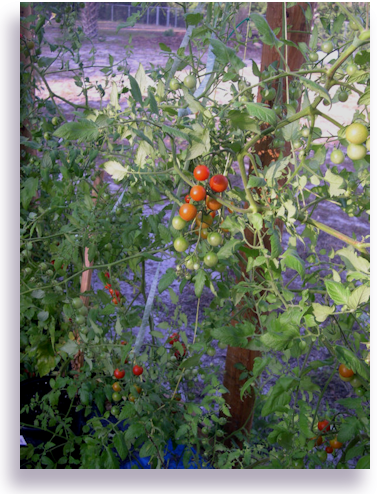 I remember as a child, the taste of a tomato as a juicy, sweet and seed packed fruit that was hard to resist. Today, the supermarket types seem almost tasteless. It's not my tastebuds either. I've heard this from many folks through the years. The hothouses of today grow them so quickly, and in such abundance with so many chemicals, the tomatoes of yester-year seem only a distant memory. No sugar, no taste, except maybe flat. And that wax coating also contains pesticides. It's almost impossible to wash off.
I remember as a child, the taste of a tomato as a juicy, sweet and seed packed fruit that was hard to resist. Today, the supermarket types seem almost tasteless. It's not my tastebuds either. I've heard this from many folks through the years. The hothouses of today grow them so quickly, and in such abundance with so many chemicals, the tomatoes of yester-year seem only a distant memory. No sugar, no taste, except maybe flat. And that wax coating also contains pesticides. It's almost impossible to wash off.
Heirlooms have a higher sugar content, and will give you that taste of eras gone by 'maters. The commonly grown hybrid tomatoes of today have lost that sugar content of 10 or more, through breeding for disease and pest resistance. These hybrids only register out a 5 (or less) sugar content, half or less than the heirlooms. The industry is only now beginning to take note and try to change this through new, sweeter cutlivars to offer in upcoming seeds and plant offerings to tomato gardeners.
I wrote this page so we gardeners can alter this through our own gardening skills. Those of us who can effectively find the space, can grow super fat, juicy, real tasting tomatoes like the ones we remember as children. To do that, we will need to first know the ideal conditions for growing yummy tomatoes.
The premium soil for tomatoes is a very rich, well draining soil that is slightly acidic. A PH range of 6.0 to 6.5 is desirable for tomato crops. If you plan on placing the plants directly into the earth, work it the fall before planting them out, by digging about 18 inches or so down, and tilling in well rotted compost, bonemeal, fishmeal and dried kelp meal. Use equal amounts of about 10 percent to the volume of compost. Tomatoes also love poultry droppings/litter. Beds using poultry litter typically yield up to 20 percent higher amounts of tomatoes per acre. Rabbit droppings are also good for tomato beds. Make sure the soil is well aerated and loose. If the area you want to grow them is tightly packed or too clayey, try raised bed gardening instead.
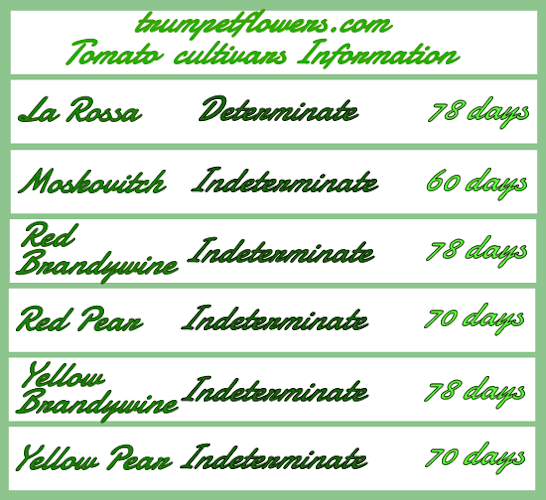
The times to harvest in above table mean from the time they are transplanted out to the garden. In other words, if it took you 6 weeks to get your seed up and ready to place out in the garden, it will be say, another 78 days until they begin to ripen and you can begin to harvest them. All seed packets should be read the same, a good point to note.
If you live way up north, (zone 5 and lower) and want to get a big headstart, forget the starting of your seeds to transplants 6 to 8 weeks before planting out, and start them 8 to 10 weeks ahead of time. You can coldframe them when they are ready to be taken outside, and will have tomatoes weeks before everyone else. In this way, you will also have tomatoes later in the year, as tomatoes have the unique ability to grow from a vine stem that is placed underground and then brought back up. This will cause it to create roots and a new plant within just a few weeks. Cut it loose and grow it onwards as a new plant. Remember too, coldframing can be used at the onset of fall temperatures, and that will keep your outdoor crop going a few more weeks into the cooler fall climate.
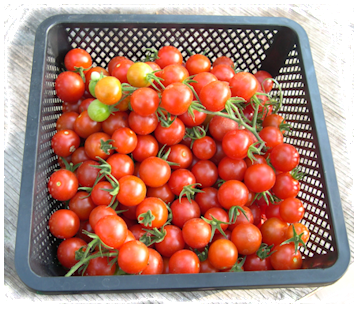 Down here in the south, you want to start them from seed in late September. Our summer temperatures are just too hot for them, and most lose their summer starts to heat and the abundance of insects that occur at this time.
Down here in the south, you want to start them from seed in late September. Our summer temperatures are just too hot for them, and most lose their summer starts to heat and the abundance of insects that occur at this time.
Put the seeds and seedlings in a protected area in dappled sunlight and low wind area(outside) until the roots just begin to peek out the bottom of the seedling container they are in. Then transplant to either a deep 4 inch pot, or go ahead and pot out into a contained bed, or plot you have prepared. They will do best in a raised bed, where you can control the amount of fertilizer, water and what kind of soil they get. Raised beds also make it easier for those of us in zone 9 to throw the occasional sheet over them in the fear of a light frost. If you are not sure what zone you live in, check out this newly updated map from the USDA. Planting Zone Map.
Repotting tomatoes is a good thing. It encourages an extensive root system and keeps them growing vigorously. Repot them several times if needed, while still indoors.(up north) And when planting in their final container (or the ground or raised bed) don't forget to bury half of the plant, after stripping off the leaves that will be underground. This will make for a much stronger top growth and even more roots. You can also trench plant them, as shown in the photo.

Tomatoes drink a lot of water. They also like fertilizer like it's going out of style. Every plant I've run into in the Solanaceae family, is a heavy feeder. Remember, the name of this website is trumpetflowers∼and they are also solanaceae. Keeping your tomatoes moist at their feet, and properly fertilized, will give you the bumper crop you deserve. If you are not picky about ferts, MiracleGro will work just fine, with foliar spraying of powdered kelp added to water once a week, you will have the best tomatoes in the neighborhood. If you are picky and like the idea of organic tomatoes, try Fish emulsion once weekly according to the bottle directions, from planting out time until the blossoms have formed. Of course, always use the spray kelp foliar feeding for best results, even if you do the fish emulsion feeding.
Perfect outdoor daytime temperatures for growing tomatoes is temperatures between 70° and 85°. Evenings that dip below 55° are not appreciated by tomatoes, but they will grow, just slower. Ideal humidity levels are between 40% and 70%.
Fertilizer for tomatoes is really the same as for brugmansia. They are cousins, so it makes perfect sense. Rub the young leaf of any brugmansia, and you smell tomato! To read about how I fertilize my brugmansia, hence the same for my tomatoes, try this: Fertilizers for Brugmansia.And for foliar feeding tomatoes, try this link: Brugmansia Tea.I will add, that if organic fertilizers for your tomatoes are what you are after, then use Magic Mater, ( ◄ See experiment with Magic Mater and results ) Alfalfa pellets, and Compost or Manure Teas. Fish Emulsions are also fantastic, and can be bought at any big box store. They get pricey. If you are into fishing, save the scraps and run through a food processor in water. It's nasty smelling, but a good, cheap way to get fish emulsion for practically nothing.
Determinate or Indeterminate vines? Let me just say that in my experience, even the tomato cultivars whose package claims they are 'determinate,' still need support of some kind. From growing tomatoes almost every year for the last 15 years, I personally like the indeterminate varieties best. Tomato plants can get quite large, growing well over 20 feet in length! I have tried growing them in screenhouses, with the added benefit of not having to fight insect pests, and the ability to stake them directly to the sides of the screenhouse and it's own support. (Top picture shows this)I have also placed them in tomato cages, and these are my second choice. If you don't have the room for a screenhouse, I suggest the cages. They are easy to make from hardware cloth, and easy to store when not in use. Even 'determinate' vines (ones that are supposed to bush and support themselves) will do better when caged.
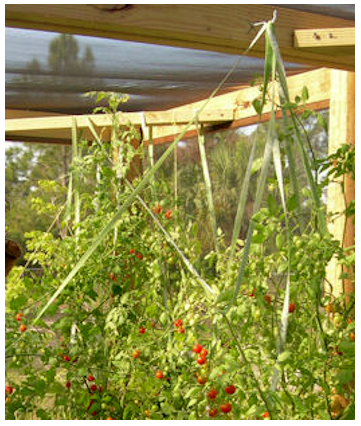 What to use to hold them up? Sometimes, the tomato plant stems will need to be tied, even if caged. I tried the wire ties, and found them insufficient. Tomato vines get very heavy when laden with fruit, and the plastic covered wire ties always break under this pressure, no matter the quality I bought. But last year, I found the perfect solution. Velcro! They now make velcro strips especially for staking out vines, and the packages can be found right in your larger garden centers. They are very reasonably priced, and sold in a roll, that you can cut to size. When the season is done, they are easy to remove, repackage, and save for next year. And, they hold the weight. I will never go back!
What to use to hold them up? Sometimes, the tomato plant stems will need to be tied, even if caged. I tried the wire ties, and found them insufficient. Tomato vines get very heavy when laden with fruit, and the plastic covered wire ties always break under this pressure, no matter the quality I bought. But last year, I found the perfect solution. Velcro! They now make velcro strips especially for staking out vines, and the packages can be found right in your larger garden centers. They are very reasonably priced, and sold in a roll, that you can cut to size. When the season is done, they are easy to remove, repackage, and save for next year. And, they hold the weight. I will never go back!
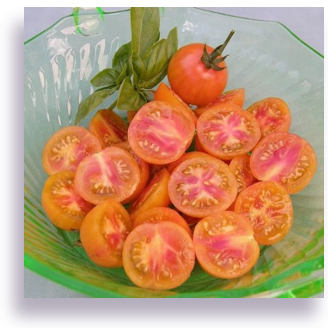 Cold and Heat Resistant types of tomatoes are bred specifically to deal with each of these situations. Beefsteaks are the best for cooler climes, while grape and cherry tomatoes can take the heat. Keep this in mind if you have very long or hot summers. Cherry cultivars will keep going long after the other types have died back, if in this situation. But also know that tomatoes bred to take the heat also need more time to ripen. If your growing season is short, go with the beef steaks. If you are in the south like me, try a wonderful, 2012 Northern California Festival award winning heirloom cherry called Isis Candy. Yumm!
Cold and Heat Resistant types of tomatoes are bred specifically to deal with each of these situations. Beefsteaks are the best for cooler climes, while grape and cherry tomatoes can take the heat. Keep this in mind if you have very long or hot summers. Cherry cultivars will keep going long after the other types have died back, if in this situation. But also know that tomatoes bred to take the heat also need more time to ripen. If your growing season is short, go with the beef steaks. If you are in the south like me, try a wonderful, 2012 Northern California Festival award winning heirloom cherry called Isis Candy. Yumm!
For more excellent reading on heirlooms, flavor, and just all around know how on tomatoes, try this wonderful read: Heirloom Tomato Plants
Tags: tomatoes, grow super tomatoes, tomato growing tips, grow bumpercrops of tomatoes, tomato gardening, tomatoes in south florida, tomato gardening in florida,


